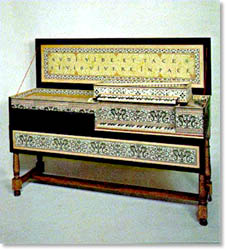'Mother'
and 'Child' after examples of Ruckers
(Available as a kit)
 Closed, the Flemish virginal looks like nothing so much as an elongated linen
closet. Open, the visual effect is striking. The keyboard is surrounded by decorative
block printed papers of the sort the Ruckers would have used. These papers also cover the
front of the case and line the inside of the fallboard as well as the case above the
soundboard, and the interior of the lid. The possibility of adding mottoes to the lid and
fallboard, and painting figures of flowers and birds on the soundboard should not be
overlooked. Although sober, even somber, with the lid down and the fallboard up, the
effect sought by the old makers was a riot of color and detail when the instruments were
open to be played.
Closed, the Flemish virginal looks like nothing so much as an elongated linen
closet. Open, the visual effect is striking. The keyboard is surrounded by decorative
block printed papers of the sort the Ruckers would have used. These papers also cover the
front of the case and line the inside of the fallboard as well as the case above the
soundboard, and the interior of the lid. The possibility of adding mottoes to the lid and
fallboard, and painting figures of flowers and birds on the soundboard should not be
overlooked. Although sober, even somber, with the lid down and the fallboard up, the
effect sought by the old makers was a riot of color and detail when the instruments were
open to be played.
Flemish virginals emerged in the 17th century as two
distinct instruments depending on which side of the front of the instrument the keyboard
was located. Those with keyboard positioned to the right were known as muselars and
produced a round, fluty sound of unusual power. The spinet whose keyboard lies to
the left of the center produces a sound approaching that of the wing-shaped harpsichord of
the period. This is explained by the fact that with the keyboard to the left, the
instrument's jacks pluck the strings at points similar to those that would have been found
in an instrument with a bentside.
The ottavino or "child" is a diminutive spinet
virginal whose construction generally parallels that of its larger relative. The main
differences lies in the fact that the keyboard of the ottavino instead of being
recessed, projects between two scrolls from one of the long sides of the virginal. It is
made without a lid, has a moulding of its own size that runs completely around the top of
its four straight sides, and is intended to be covered with block printed papers all
around.
As its name would imply, the ottavino is pitched one
octave higher than either the spinet or muselar or, in the parlance, at
four-foot pitch . It stores easily in the body of the large virginal, hence the term from
the old Flamands, "Mother and Child." It can be played either by itself on a lap
or table, or placed atop the large virginal from which the jack rail has been removed and
played from the keyboard of the large virginal. In the latter case, one is playing a
double-manual virginal disposed 1 x 8', 1 x 4' on the lower manual and 1 x 4' on the
upper. The only manner of uncoupling the two instruments is to lift the ottavino
off its mother and replace the mother's jack rail.
